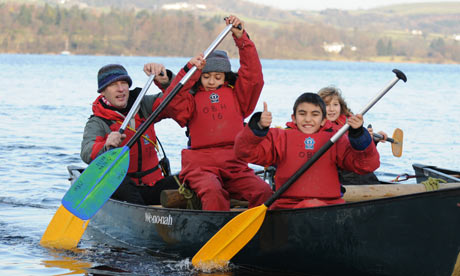
A fortnight after returning from a course with the Outward Bound Trust in north Wales, Shenley Academy's year 8 pupils are full of enthusiasm for the life-enhancing effects of a week of rock-climbing, gorge-walking and overnight expeditions. Jack Davis says he hadn't realised how determined he could be, Charlie Hannam was surprised at her own mental strength and Callum Wallace found he rather enjoyed being a group leader.
The impact of the trip runs deep for these 12- and 13-year-olds. Charlotte Owen says she often used to feel self-conscious, but has gained so much confidence that she plans to audition for the south Birmingham school's music evening.
Such glowing testimonies are useful for charities, but as an ever more austere funding environment puts them under greater pressure to prove the worth of their work, anecdotal evidence may no longer be enough.
That is why at Shenley, the 160 pupils in year 8 have also been documenting the effect of the trip in data form. A new "wellbeing measure" allows organisations working with 11- to 16-year-olds to track the change over time in areas such as self-esteem, resilience and satisfaction with family and community life.
Young people are asked to first mark how strongly they agree or disagree with a number of statements – "I feel my life has a sense of purpose" and "I wish I lived somewhere else", for example – before they do whatever activity or work the group offers. The questions must be answered again a few weeks after it is completed.
For each area of wellbeing, the group being surveyed is given a score of between zero and 100. Eventually, they end up with a set of scores from before they did the activity or course, and one from after – hopefully showing improvement. So far, at least 3,000 young people across the UK have completed the survey, through more than 40 organisations, including Action for Children, Save the Children and Toynbee Hall, a community organisation working to eradicate poverty in east London. Most are charities, but some schools and youth groups are also signed up.
"Budgets are being slashed and there are all these moves toward outcomes-based initiatives and payment by results that favour people who've got easy ways of measuring what they do," says John Copps, who heads the team at New Philanthropy Capital (NPC), which created the wellbeing measure. "If you're a charity focused on soft skills, like improving self-esteem, the tool will quantify those things."
NPC is not the only organisation measuring wellbeing. The Office for National Statistics is due to deliver the first official "happiness index" in July. The prime minister insists that such an index could lead to policy that is "more focused not just on the bottom line but on all those things that make life worthwhile".
Outward Bound has already put around 1,000 young people through the questionnaire. "It helps us to stand out from the crowd," says Emma Ferris, the organisation's head of impact evaluation.
An evaluation of the responses of 691 young people showed that girls saw greater improvements in self-esteem, emotional wellbeing and resilience from going on Outward Bound courses than boys.
Toynbee Hall used the measure to assess its Aspire programme, which works over a year to improve the confidence and wellbeing of 80 vulnerable or isolated teenagers. It found significant improvements in their satisfaction with their schools and community, and increased resilience and life satisfaction. Now it is seeking funding to put the same 13- and 14-year-olds through a second year of the programme. Having those results is crucial, says community learning manager Marcus Duran.
"With something like wellbeing, which can seem quite intangible, it's so easy for funders to turn round and say, 'It's all very pretty and very nice but what difference is it making?'" he says. "You do really have to fight your corner, and being able to say, 'This is the national picture and this is what we're doing,' puts you in a much better position than just saying, 'The kids are happy.' It gives us kudos to be able to say we're not making this stuff up."

